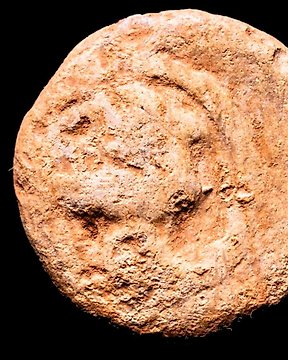
Hispanie antique. Lead of Roman times, Monetiform animal to left in obverse and palm leaf in reverse, both into circle. (Sans Prix de Réserve)
Nº 84046691

Nº 84046691

Ancient "Silk Road" 20 Silver Coins Collection 700 B.C. - 1800 A.D.
Each coin is protected in an archival capsule and beautifully displayed in a deluxe custom-made cherry hardwood case.
Authenticated by the Royal Mint in 2007.
1 Taxila 1/8 Satamana 7/4th CBC
2 Mauryan Punch Mark 3rd CBC
3 Bactria Kings Drachm 2/1st CBC
4 W. Satraps Drachm 2/4th CAD
5 Rome Antoninianus 3rd CAD
6 Shahi Jital 9th CAD
7 Ghaznavid Dirham 10/12th CAD
8 Amirs Of Sind Damma 11th CAD
9 Ayyubid Dirham 12/13th CAD
10 Armenia Tram 13th CAD
11 Ilkhanid Dirham 13/14th CAD
12 Mamluk Dirham 13/15th CAD
13 Muzaffarid Dirham 14th CAD
14 Eretnid Dirham 14th CAD
15 Safavid 4 Shahi 14/17th CAD
16 Hungary Dinar 16/17th CAD
17 Ottoman fraction 16/17th CAD
18 Russia Kopek 17/18th CAD
19 Nepal Dam 18th CAD
20 India Chukram 19th CAD
Named in the middle of the 19th century by the German scholar, Baron Ferdinand von Richthofen, the Ancient Silk Road stretched thousands of miles through deserts and mountains from China to Europe. Zhang Qian first traveled it when he was sent on a diplomatic mission to the Western Regions in the Han dynasty (206 BC-AD 220). At that point in history the Han dynasty and the empire of Parthia in Persia were in their Golden Ages, which supported the smooth development of this route. The Silk Road was the information super highway of its time, serving as the conduit not only for trade, but also for the transmission of knowledge and ideas between East and West. It prompted an explosion of long and short-lived civilizations and a large array of different ancient currencies over the centuries.
When the Silk Road was first established, silk was not the chief commodity. The Han dynasty made very little profit from it until the Romans discovered silk. The Romans loved silk so much that they even exchanged silk for its weight in gold. During the Tang dynasty, thirty percent of the trade on the Silk Road was comprised of silk.
In the early middle ages, with the spreading of various religions in the world, more and more missionaries reached to the East by this road. With the Silk Road acting as a conduit, the exchange of ideas grew to a larger scale than ever before. The discovery of a sea route from Europe to Asia in the late 15th century dealt a damaging blow to the Silk Road trade. With less cost, harassment and danger, many goods and materials were now conveyed through the sea route. Also, the Persians had mastered the art of sericulture and the import of the silk from the East was reduced.
Thereafter, the prosperous Silk Road declined. The bustling streets, wealthy cities and solid ramparts now are submerged in the vast desert, and today, people can only trace its splendid history in the endless ruined and dilapidated remains, and the few ancient coins that were hidden away. Many of these civilizations are known only by the rare coins that remain.
The unique collection of genuine coins of the Silk Road Civilizations presented here are the result of many years of laborious and fortuitous accumulation of small groups of coins from dozens of sources from around the world.
International insured shipping with DPDexpress or ExpressMail.
Combined shipping available.
Comment acheter sur Catawiki ?
1. Découvrez des objets d’exception
2. Faites la meilleure offre
3. Effectuez un paiement sécurisé